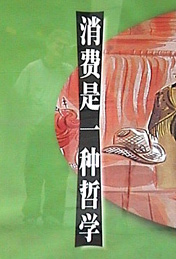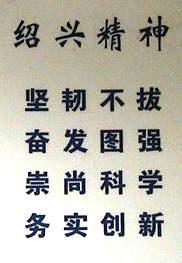"China's Public Advertising Culture:
Spiritual Civilization, Local Development,
Privatization and Public Service"
| |
 |
|
 |
|
|
|
|
|
|
|
 |
|
|
|
|
|
|
|
| |
 |
|
 |
|
|
|
|
|
|
|
 |
|
|
|
|
|
|
|
Nowhere is the transformation of Chinese society more visible than in the marketization of public communication and advertising culture. Red forests of Coca Cola billboards have replaced "Red Oceans" of Maoist slogans. Propaganda organs have become advertising firms. Since 1978 the Chinese Communist Party (CCP) has both decentralized state political and economic authority and marketized its monopoly control over the economy, resulting in high economic growth and the privatization of economic institutions at the local level. Unlike the transitions from one-party rule in the former Soviet Union and Eastern Europe, however, the CCP has largely maintained control over the political content of mass media communication. Newspapers, television and radio still voice the Party line, and Party slogans can still be found on walls and on banners waving overhead.
But the combined forces of decentralization and marketization in the context of transnationalization produce striking images for those strolling down China's boulevards. The CCP still advances its agenda of "Constructing a Socialist Civic Identity," and promoting the leadership of the Party in all spheres and activities. But more and more it must do so using the sophisticated imagery, styles and formats of commercial advertising in Hong Kong, Singapore and Taiwan. One way to do this has been to piggy-back on commercial advertising: merging political messages and public service announcements with the hawking of goods and products. Another way has been to recognize the resurgence of regionalism and decentralization by giving political advertising a local spin and promoting the goals of local economic development (e.g. Shanghai's gilded age, Beijing's Imperial legacy, Xian's Develop the West campaign, etc.). Both means offer the opportunity to increase the visibility of these political messages, but at the risk of diluting or transforming their content. As the images contained in this archive demonstrate, marketization and decentralization are producing new forms and styles of advertising culture in China today.
For a more thorough discussion of these trends see Steven W. Lewis, "'What Can I Do For Shanghai?' Selling Spiritual Civilization in Chinese Cities," in Stephanie Hemelryk Donald, Michael Keane and Yin Hong, eds., Media in China: Consumption, Content and Crisis, (RoutledgeCurzon: 2002), pp. 139-151.
This archive of 247 digital images of 211 advertisements was created to provide visual referents for students and scholars trying to understand these important changes in Chinese consumerism and advertising culture.* The archive comprises surveys of outdoor public service announcements and political advertisements on the major thoroughfares of eight of China's major cities and tourist destinations: Shanghai and Beijing in 1997 and 1998; Chengdu (Sichuan Province) in 1999; Xian (Shanxi Province) and the Three Gorges Dam Project (Chongqing Municipality and Hubei Province) in 2000; and Chengde (Hebei Province), and Hangzhou and Shaoxing (Zhejiang Province) in 2002.
*The images were initially collected by Steven W. Lewis in doing research for, "Selling the Pulpit: Exploring the Decentralization and Marketization of Political Advertising in China Today," a paper presented at the Annual Symposium of the Center for Chinese Studies, University of California, Berkeley, March 13-14, 1998, and indirectly supported in 2002 by a Freeman Foundation grant to Rice University and the East Asia Institute at Columbia University to conduct a study tour of Chinese cities by Texas teachers.